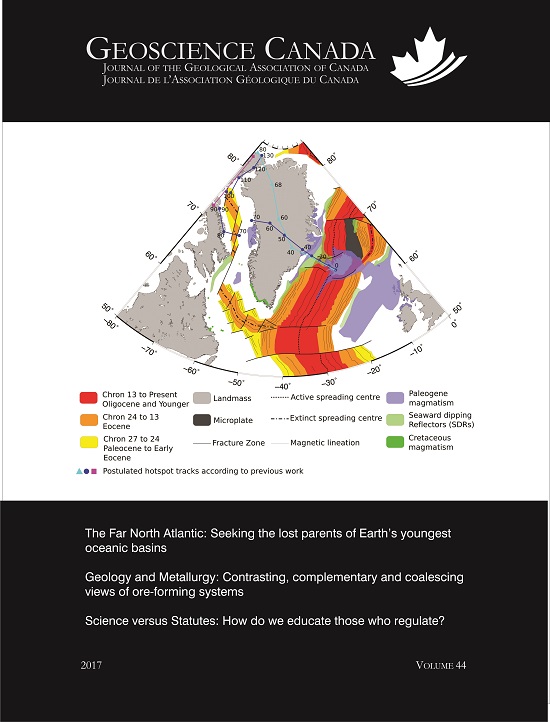Published 2017-10-06
How to Cite
Abstract
Breakup between Greenland and Canada resulted in oceanic spreading in the Labrador Sea and Baffin Bay. These ocean basins are connected through the Davis Strait, a bathymetric high comprising primarily continental lithosphere, and the focus of the West Greenland Tertiary volcanic province. It has been suggested that a mantle plume facilitated this breakup and generated the associated magmatism. Plume-driven breakup predicts that the earliest, most extensive rifting, magmatism and initial seafloor spreading starts in the same locality, where the postulated plume impinged. Observations from the Labrador Sea–Baffin Bay area do not accord with these predictions. Thus, the plume hypothesis is not confirmed at this locality unless major ad hoc variants are accepted. A model that fits the observations better involves a thick continental lithospheric keel of orogenic origin beneath the Davis Strait that blocked the northward-propagating Labrador Sea rift resulting in locally enhanced magmatism. The Davis Strait lithosphere was thicker and more resilient to rifting because the adjacent Paleoproterozoic Nagssugtoqidian and Torngat orogenic belts contain structures unfavourably orientated with respect to the extensional stress field at the time.
RÉSUMÉ
La cassure entre le Groenland et le Canada a entraîné une expansion océanique de la mer du Labrador et de la baie de Baffin. Ces bassins océaniques sont reliés par le détroit de Davis, un haut bathymétrique constitué principalement de lithosphère continentale et de la province volcanique tertiaire de l'ouest du Groenland. Il a été suggéré qu'un panache du manteau a facilité cette cassure et généré le magmatisme associé. L’hypothèse d’une cassure produite par panache du manteau prédit que la première distension océanique, la plus importante, le magmatisme et l'expansion océanique initial se produisent là où le panache mantélique touche la croûte continentale. Or les observations dans la région de la mer du Labrador–baie de Baffin ne correspondent pas à ces prédictions. Et donc l'hypothèse du panache ne fonctionne pas dans cette région à moins que des facteurs ad hoc déterminants ne soient présents. Un modèle qui correspond mieux aux observations présuppose la présence d’une épaisse quille lithosphérique continentale d'origine orogénique sous le détroit de Davis qui aurait bloqué l’expansion océanique de la mer du Labrador vers le nord, ce qui aurait provoqué une augmentation du magmatisme localement. La lithosphère du détroit de Davis était plus épaisse et plus résistante à l’expansion océanique parce que les bandes orogéniques paléoprotérozoïques du Nagssugtoqidian et de Torngat renferment des structures défavorablement orientées par rapport au champ de contraintes d’extensions de l'époque.

